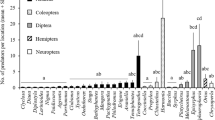Abstract
Populations of pear psylla,Cacopsylla pyri (L.) (Rhynchota: Psyllidae), and its natural enemies were sampled on pears in Antalya province during the years 2000–2002. Thirty-two species of predators and three species of parasitoids were detected to be associated withC. pyri in Antalya province. The heteropterans (especially anthocorid species) were the most abundant predator group. Among the anthocorids,Anthocoris nemoralis (Fabricius) (Heteroptera: Anthocoridae), whose population was closely related to the dynamics of the pear psylla population, was generally the principal antagonist ofC. pyri. Other species recorded during the study were the miridDeraeocoris spp., the chrysopidChrysoperla carnea L., and many coccinellid species. Although these predators are polyphagous, as are theOrius species, their populations were related to the psylla fluctuations. Among the parasitoid complex belonging to the order Hymenoptera, the encyrtidTrechnites psyllae (Ruschka) was the only primary parasitoid. Two hyperparasites,viz., Syrphophagus mamitus (Walker) andPachyneuron aphidis (Bouché) (Encyrtidae and Pteromalidae, respectively), were detected in the surveys. Also, this study revealed new information concerning the pear psylla parasitoid complex in Turkey. WhileT. psyllae andS. mamitus are new records to Turkish parasitoid fauna,C. pyri is a new host record forP. aphidis. The population development and abundance of pear psylla and its natural enemies, as well as the parasitization rates in treated and untreated pear orchards, are presented here.
Similar content being viewed by others
References
Anon. (1991) Integrated pest management for apples and pears.Publ. 3340 Univ. of California, Div. of Agriculture and Natural Resources, Oakland, CA, USA.
Berrada, S. and Nguyen, T.X. (1994) Resistance of pear psylla to phosphorus compound, Monocrotophos.IOBC/WPRS Bull. 17(2):34–38 (French, with English abstract).
Buès, R. and Boudinhon, L. (2002) Insecticide resistance in the pear psylla.Acta Hortic. 596:567–570.
Carraro, L. (1998) Transmission of pear decline by using naturally infectedCacopsylla pyri L.Acta Hortic. 472:665–668.
Ciglar, I and Barić, B. (1992) Control of pear psyllaPsylla pyri L. (Homoptera: Psyllidae) in commercial orchards in North-East of Croatia, Yugoslavia.Acta Phytopathol. Entomol. Hung. 27:155–163.
Herard, F. (1985) Analysis of parasite and predator populations observed in pear orchards infested byPsylla pyri (L.) (Hom.: Psyllidae) in France.Agronomie 5:773–778.
Herard, F. (1986) Annotated list of the entomophagous complex associated with pear psylla,Psylla pyri (L.) (Hom.: Psyllidae) in France.Agronomie 6:1–34.
Hodkinson, I.D. (1984) The taxonomy, distribution and host plant range of the pear-feeding psyllids (Homoptera: Psylloides).IOBC/WPRS Bull. 7:32–44.
Julien, J. (1984) The economic importance of pear psyllids for the production of pears in France.IOBC/WPRS Bull. 7:7–12 (French, with English abstract).
Kovancı, B., Gencer, N.S., Kaya, M. and Akbudak, B. (2000) Investigations on the population fluctuations ofCacopsylla pyri (L.) (Homoptera: Psyllidae) in Uludag University Agricultural Faculty pear orchard.Turk. J. Entomol. 24:289–300 (Turkish, with English abstract).
Öncüer, C. (1991) [A catalogue of the parasites and predators of insect pests of Turkey.] Ege University, Faculty of Agriculture Res. Publ. no. 505. University Press, İzmir, Turkey (in Turkish).
Önder, F. (1982) Taxonomic and faunistic studies on the fauna of Anthocoridae (Heteroptera) in Turkey. Ege University, Faculty of Agriculture Res. Publ. no. 459. University Press, İzmir, Turkey (Turkish, with English abstract).
Önuçar, A. (1983) Investigations on psyllid species (Homoptera: Psyllidae) which are harmful on various plants in İzmir and surrounding areas, their morphologies, host-plants and taxonomic positions. Ministry of Agriculture and Forestry Research Publ. no. 44. Ankara, Turkey (Turkish, with English abstract).
Paulson, G.S. and Akre, R.D. (1991) Parasitic hymenoptera collected from a pear orchard under organic management in Washington State.Entomol. News 102:227–230.
Pekár, S. (1999) Effect of IPM practices and conventional spraying on spider populations dynamics in an apple orchard.Agric. Ecosyst. Environ. 73:205–210.
Rapisarda, C. and Siscaro, G. (1990) Notes on the pear psyllids of Sicily.Tec. Agric. (Catania) 42:31–44 (Italian, with English abstract).
Schaub, L., Bloesch, B., Aeschlimann, U. and Garnier, G. (2001) Monitoring resistance of pear psyllaCacopsylla pyri to amitraz.IOBC/WPRS Bull. 24:151–153.
Schaub, L., Bloesch, B., Bencheikh, M. and Pigeaud, A. (1996) Spatial distribution of teflubenzuron resistance by pear psylla in western Switzerland.Acta Hortic. 422:311–314.
Scutareanu, P., Drukker, B. and Sabelis, M.W. (1994) Local population dynamics of pear psyllids and their anthocorid predators.IOBC/WPRS Bull. 17:18–22.
StĂubli, A. (1984) The economic importance of pear psyllids for the production of pears in Switzerland.IOBC/WPRS Bull. 7:16–22 (French, with English abstract).
Uygun, N. (1981) Taksonomische Untersuchungen über die Coccinellidenfauna (Coleoptera) der Türkei. Çukurova University, Faculty of Agriculture Res. Publ. no. 157/48. Adana, Turkey (Turkish, with German abstract).
Author information
Authors and Affiliations
Corresponding author
Additional information
http://www.phytoparasitica.org posting May 6, 2004.
Rights and permissions
About this article
Cite this article
Erler, F. Natural enemies of the pear psyllaCacopsylla pyri in treatedvs untreated pear orchards in Antalya, Turkey. Phytoparasitica 32, 295–304 (2004). https://doi.org/10.1007/BF02979824
Received:
Accepted:
Issue Date:
DOI: https://doi.org/10.1007/BF02979824




